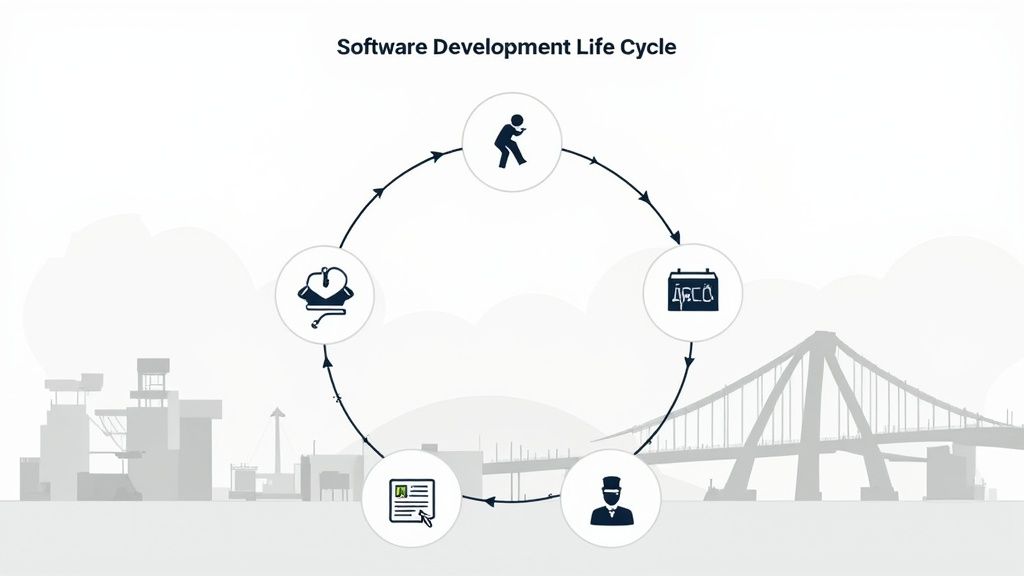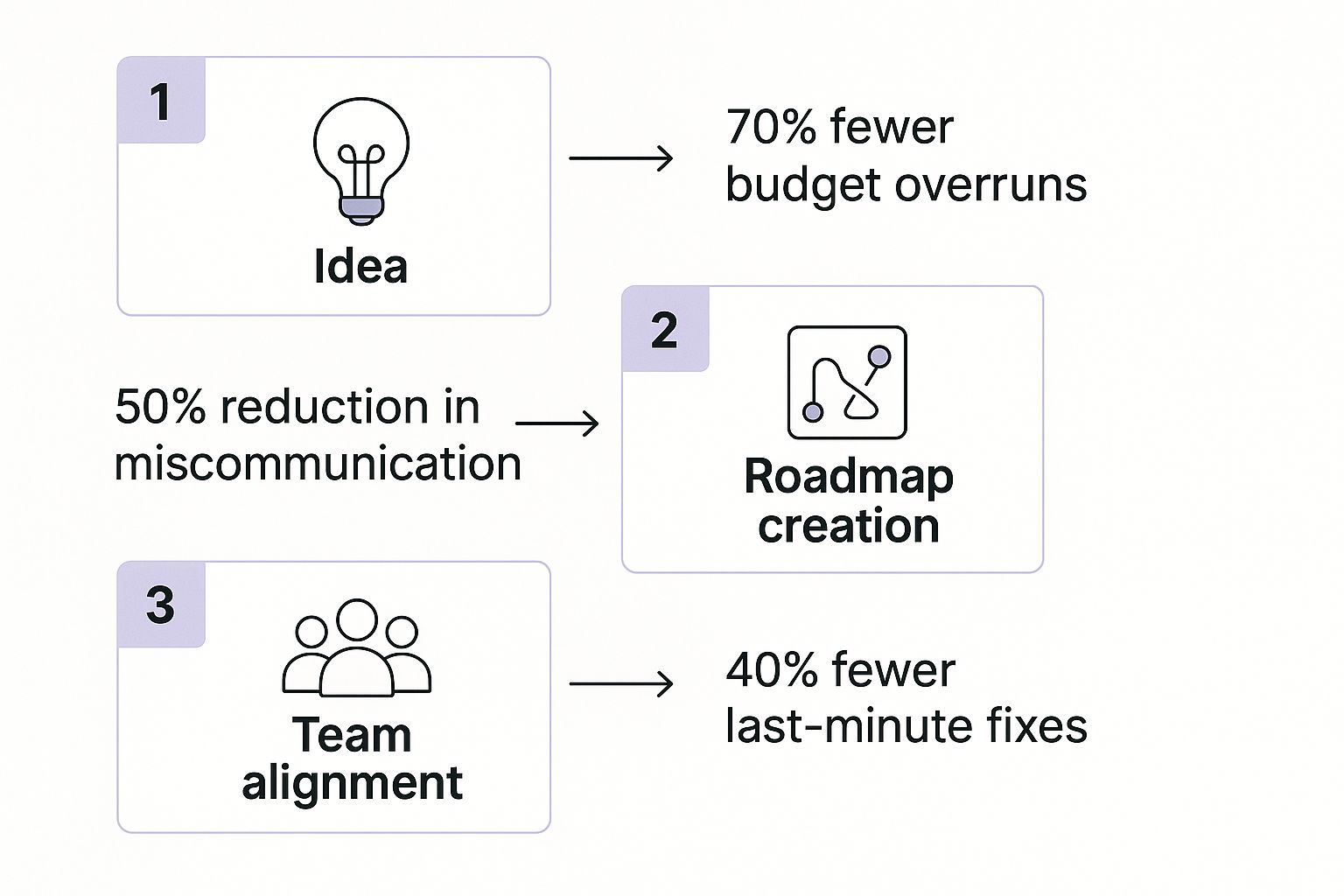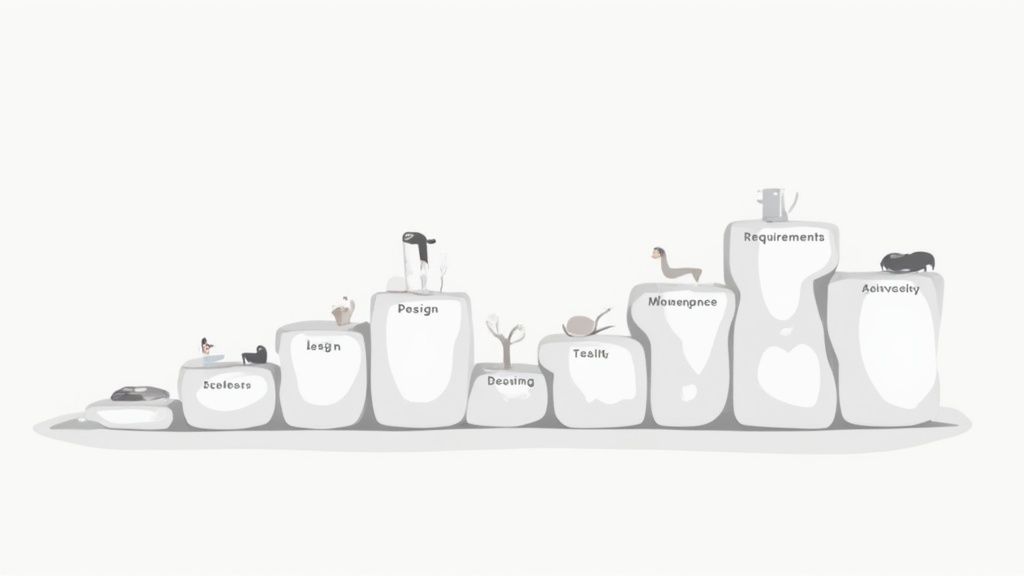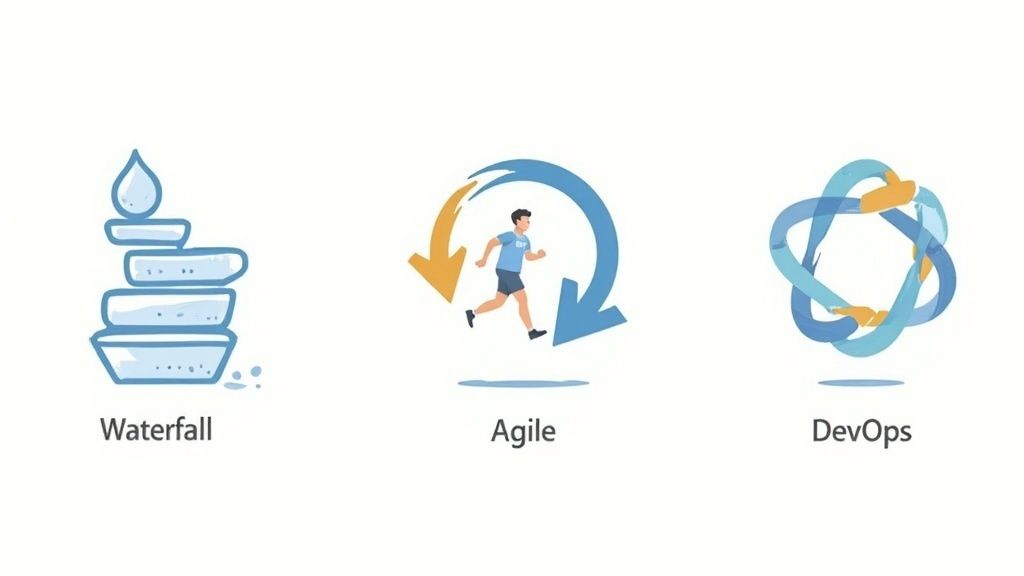
Let's be honest, "Software Development Life Cycle" sounds like corporate jargon invented to make meetings longer. But it’s really just a fancy name for a roadmap that turns a great idea into working software—without setting your budget on fire.
The SDLC is a structured process that guides your project from a back-of-the-napkin sketch to long-term maintenance. It's about making sure everyone on your team is building the same thing, the same way, and not accidentally building a Frankenstein's monster of code.
Think of it this way: the SDLC is the difference between a Michelin-star kitchen following a precise recipe and just flinging ingredients at the wall hoping a gourmet meal appears. It’s not about rigid, soul-crushing rules. It's about giving your team a shared playbook so they’re all rowing in the same direction.
This playbook is your best defense against the dreaded "scope creep" that quietly turns a two-month project into a two-year nightmare. Winging it is simply the fastest way to build something nobody asked for, delivered late and over budget.
This whole concept isn't some new fad. The SDLC originated in the 1960s to solve the "software crisis"—a chaotic time when projects were constantly late, wildly over budget, and often failed completely. With around 70% of projects still experiencing schedule overruns today, the need for order is as critical as ever.
The goal of an SDLC isn't to add bureaucracy; it's to remove chaos. It forces the hard conversations upfront so you're not making panicked decisions at 2 AM before a launch.
This infographic breaks down how a simple, jargon-free process flow directly impacts your bottom line.

As you can see, simple steps like creating a roadmap and aligning the team aren't just feel-good exercises. They have a measurable impact on reducing budget overruns and preventing those costly last-minute fixes.
To really appreciate the SDLC, it helps to see how each phase directly prevents a common business headache. Here's a quick breakdown of what each stage is really for.
| Phase | What It Really Means | Why It Saves Your Bacon |
|---|---|---|
| Planning | Figuring out what to build and why it matters. | Prevents building a gorgeous solution for a problem that doesn't exist. |
| Requirements | Defining exactly what the software must do. | Stops endless feature requests and "scope creep" later on. |
| Design | Creating the architectural blueprint for the software. | Keeps the tech stack from becoming a messy, unfixable tangle. |
| Development | Actually writing the code based on the blueprint. | Ensures engineers are building the right thing the right way. |
| Testing | Trying to break the software to find bugs. | Catches critical errors before your customers do (and tweet about it). |
| Deployment | Pushing the finished software out to users. | A smooth launch avoids day-one crashes and angry support tickets. |
| Maintenance | Keeping the software running and up-to-date. | Protects your initial investment and keeps users happy long-term. |
Each step builds on the last, creating a logical flow that turns a vague idea into a stable, valuable product. Skipping a phase is like trying to build a house by putting up the roof before the foundation is poured—it’s just not going to end well.
Ultimately, understanding the SDLC demystifies the entire software creation process. And for a modern take on this, exploring concepts like no-code development offers a fresh perspective on building applications without getting bogged down in traditional programming.
Every software project, whether you follow a strict methodology or not, goes through a predictable lifecycle. This isn't just theory; it’s a map of what actually happens when you’re trying to turn an idea into a working product.
Think of the software development life cycle like building a house. You wouldn't just dump a pile of lumber on a plot of land and start hammering. There's a process: you draft blueprints, pour a foundation, frame the walls, and then handle the plumbing and electrical. Software is built on the same principle of structured, sequential progress.
This is where the dream meets reality. The core goal here is brutally simple: figure out if the project is even worth doing. You’ll dive into the business case, estimate the resources needed (time, money, people), and run a feasibility study. Is this a game-changing idea or just a solution looking for a problem?
Once you get the green light, the real work starts with requirements gathering. This isn’t about writing a 300-page document that gathers dust. It's about preventing that dreaded "Oh, you wanted it to do that?" conversation six months from now. You have to talk to everyone—stakeholders, future users, the sales team—to build a crystal-clear list of what the software absolutely must do.
With your requirements locked down, it's time to create the blueprint. This phase is typically split into two key parts:
A solid design phase makes sure the development team isn’t just winging it. Improvising is a great way to build a mansion of technical debt you can never afford to pay off.
Now we get to the part where the magic happens—or at least where the coffee pot works overtime. Developers take the design documents and start writing code. They build the features, hook up the databases, and bring the user interface to life.
This is almost always the longest phase of the entire lifecycle. It's where the "doing" gets done, and strong project management is essential to keep the team on track, on schedule, and building according to the agreed-upon plan.
This classic "V-Model" gives a great visual of how these stages connect.

Notice how each development stage on the left corresponds to a testing stage on the right? This illustrates the idea that you should be planning how to validate your work from the very beginning.
As soon as developers finish a module, it gets handed over to the Quality Assurance (QA) team. Their one job? Try to break everything. They run a whole battery of tests—functional, integration, performance, security—to hunt down every bug, glitch, and usability issue they can find.
A great QA team doesn’t just find bugs; they are the guardians of your brand's reputation. Every issue they catch is one your customers will never have to deal with.
This phase is all about the feedback loop. QA finds a problem, documents it, and sends it back to development to be fixed. The cycle repeats until the software is stable, secure, and does exactly what it was supposed to do.
It's launch day. The code is clean, the tests are passed, and it's time to release your creation into the wild. This could mean pushing it to a live production server, submitting it to an app store, or distributing it directly to your customers.
Many modern teams use a phased rollout. They might release the new software to a small percentage of users first, letting them monitor performance and iron out any last-minute kinks before a full-scale launch.
Shipping the product isn't the finish line; in many ways, it's just the start. The maintenance phase is where your software will spend most of its life. This is an ongoing process that includes:
This is the stage where great products evolve and thrive, while others are left to die a slow, buggy death. Understanding this entire journey is key, and you can see how these stages apply in practice by looking at a detailed mobile app development process guide.
Picking a software development life cycle model is like choosing a vehicle for a road trip. A Ferrari is great for a racetrack, but you wouldn't take it camping. Picking the wrong model is the fastest way to get your project stuck in the mud, burning cash and morale.
This is where most teams get it wrong. They hear a buzzword like "Agile" at a conference and try to force it onto a project that needs the rigid structure of a government contract. Let's cut through the noise and look at the big three: Waterfall, Agile, and DevOps.

This isn't just about process; it's about matching your team's culture and your project's reality to a framework that won't make everyone want to quit.
Think of Waterfall as the "measure twice, cut once" architect. It’s a linear, sequential approach where you must complete one full phase before moving on to the next. You do all your planning, then all your design, then all your coding, and so on.
There's no going back without a mountain of paperwork and a very unhappy project manager.
The Brutal Truth: Waterfall is fantastic for projects with crystal-clear, unchangeable requirements—think building a bridge or software for a medical device. But for a mobile app in a fast-moving market? Using Waterfall is like trying to steer a cruise ship with a canoe paddle.
Then there's Agile, the "build, learn, repeat" darling of every startup founder. Instead of one massive launch, Agile breaks the project into small, iterative cycles called sprints. You build a little, test a little, get feedback, and adjust course.
This model is built for a world where you don't know all the answers upfront. It embraces change, and the data backs it up: Agile projects report a 42% success rate, a massive jump from the 14% seen in traditional Waterfall projects. By 2025, it's expected that around 71% of organizations will have adopted Agile frameworks.
Of course, "being Agile" often gets mistaken for "having no plan." It requires discipline, constant communication, and a team that can self-organize. Without that, you just get chaos. Speaking of teams, if you're looking to build a high-performing Agile squad, our guide on how to hire remote developers offers key insights for finding talent that thrives in this environment.
Finally, there's DevOps. Let's be clear: this isn't just another model. It's a cultural philosophy that tears down the wall between development (Dev) and operations (Ops).
Traditionally, developers would build the software and "throw it over the wall" to the operations team to deploy and maintain. This created friction, blame games, and painfully slow releases.
DevOps merges these two worlds, focusing on automation and collaboration to create a seamless pipeline from code commit to deployment. The goal is to release smaller, more frequent updates with rock-solid reliability.
Choosing the right approach isn't an academic exercise—it directly impacts your budget, timeline, and final product. To help you visualize the trade-offs, here's a practical comparison.
Think of this table as a cheat sheet to help you decide which framework best fits your project's reality, not just the one that sounds coolest on a resume.
| Attribute | Waterfall (The Architect) | Agile (The Startup) | DevOps (The Assembly Line) |
|---|---|---|---|
| Pace & Rhythm | Slow, deliberate, and sequential. One big push. | Fast, iterative cycles (sprints). Constant rhythm. | Continuous, rapid, and automated. Always on. |
| Requirements | Fixed and defined upfront. Change is the enemy. | Flexible and evolving. Change is expected. | Dynamic and user-driven. Change is automated. |
| Team Structure | Siloed and hierarchical. Clear handoffs between phases. | Cross-functional and self-organizing. High collaboration. | Integrated Dev & Ops. Shared ownership. |
| Best For | Projects with zero ambiguity (e.g., medical devices, construction). | Projects with market uncertainty (e.g., new apps, SaaS products). | Large-scale applications needing high reliability (e.g., Netflix, Amazon). |
| Biggest Risk | Discovering a flaw late in the process, forcing a costly restart. | "Scope creep" without a strong product owner to say "no." | Cultural resistance; requires a complete mindset shift. |
Each model has its place. Waterfall provides stability when requirements are set in stone. Agile offers the flexibility to navigate uncertainty. DevOps delivers the speed and reliability needed to operate at scale. Your job is to honestly assess your project, your team, and your market to pick the vehicle that will actually get you to your destination.
Theory is clean, but reality? Reality is messy. Every leader who's ever shipped a product has the scars to prove it, and the software development life cycle is littered with landmines. It’s one thing to have a neat little diagram of your process; it’s another to watch it catch fire in the real world.
Let's talk about the mistakes that turn promising projects into cautionary tales. This isn't just a list of problems—it’s a playbook of traps I’ve personally stepped in, so you don't have to.

Ever started a project to build a simple shed and ended up planning a three-story mansion? That’s scope creep. It starts innocently with one "tiny" feature request, then another, and another.
Before you know it, your timeline is a joke, your budget is shot, and your team is burning out trying to build an entirely different product.
The cure isn't saying "no" to everything. It's having a ruthless product owner who asks one question for every new idea: "Does this get us to our launch goal, or does it distract us?" If it's the latter, it goes on a "Future Ideas" list and you move on.
Here’s a classic scenario: the design team hands off a beautiful mockup. The development team looks at it, nods, and goes off to build something that is… vaguely similar, but functionally a different beast.
Why? Because designers think in user flows and aesthetics, while developers think in database schemas and API calls. They're speaking different languages.
Without a shared vocabulary and constant check-ins, you’re not building one product; you’re building two versions of a misunderstanding.
This isn't a team problem; it’s a process problem. Daily stand-ups and shared documentation aren't just Agile rituals; they're the translators that keep everyone on the same page.
You’re behind schedule. The pressure is on. The temptation to cut corners on testing and "just ship it" is immense. Don’t do it.
Shipping a buggy product isn't a time-saver; it’s a reputation-destroyer that mortgages your future. Every bug you ignore is a future support ticket, a negative review, and a chunk of your team’s time spent firefighting instead of building what's next.
A robust QA process isn't a bottleneck; it's your brand's last line of defense. Getting this right involves a deep dive into different quality assurance testing methods to find what fits your project. Neglecting this step is choosing short-term relief for long-term pain.
Shipping your product isn't the finish line; it’s the starting gun for a whole new kind of race. Welcome to the modern software release cycle, where "done" is a myth and "final version" is a lie we tell ourselves to sleep better at night. If you’ve ever felt lost in a sea of jargon like pre-alpha, alpha, and beta, you’re not alone.
So, what’s the real difference, and which ones can you skip without mortgaging the office ping-pong table for bug bounties?
Think of it this way: pre-alpha is when the software barely works and is only shown to brave internal teams. Alpha is a bit more stable, but you’d still never let a paying customer near it. It's for your most forgiving internal testers—the ones who know how to file a bug report instead of a lawsuit.
This is where your product first meets the cruel, honest world. The modern software release cycle is highly standardized, with 60-70% of software products undergoing some form of beta testing. This process, coupled with DevOps practices, enables the 'perpetual beta' model where continuous updates are the norm, not the exception. You can read the full research about software release cycles on Wikipedia for a deeper dive.
The release candidate (RC) is your last stop. This is the version you think is ready for primetime. You release it to a wider audience, hold your breath, and pray no one finds a show-stopping bug. If it survives, congratulations—you’ve officially shipped.
But here's the kicker: the moment you ship, you start all over again. This is where Continuous Integration and Continuous Delivery (CI/CD) completely changed the game. Old-school teams would spend six months building a massive update, leading to a terrifying, high-stakes launch day.
Modern teams don't do that.
CI/CD is a philosophy, powered by automation, that lets you ship small, incremental updates multiple times a day. It’s the difference between building a skyscraper brick by brick and trying to drop a fully-formed building from a helicopter.
This is the secret sauce behind how top companies stay competitive. It’s not about one perfect launch; it’s about a constant stream of tiny, low-risk improvements. This approach is fundamental to the software development life cycle explained for today’s fast-paced environment.
This isn’t just for giant tech companies. Adopting CI/CD is one of the most impactful Agile methodology best practices any team can implement. It’s how you fix bugs before they become scandals and deliver a constant flow of value that keeps users coming back.
Alright, theory is one thing, but what happens when you’re actually in the trenches trying to make this stuff work? Let’s tackle the sharp-edged questions that pop up when the neat diagrams on a blog meet the messy reality of your project. No fluff, just straight answers.
If you have to ask, the answer is almost certainly Agile. Startups live and die on speed, flexibility, and customer feedback. You can’t afford to spend six months meticulously building the wrong product in a Waterfall vacuum. That's a death sentence.
Agile frameworks like Scrum or Kanban are built for this very chaos. They force you to ship a Minimum Viable Product (MVP) quickly, get it in front of real users, and pivot based on what people actually do—not what they claim they’ll do in a focus group. Start with Agile and iterate like your company's life depends on it. Because it does.
Think of it this way: the SDLC is the "what" and "why" of building software. It’s the architectural blueprint that outlines the core stages—planning, coding, testing, and so on.
Project management, on the other hand, is the "who," "when," and "how." It's the collection of tools and practices—like Jira boards, sprint planning, and resource allocation—that you use to navigate those stages effectively. Your choice of SDLC dictates your project management style. Trying to run an Agile process with a rigid, Waterfall-style project plan just won't work; they’re fundamentally incompatible.
The SDLC is your strategy; project management is your tactics. A brilliant strategy with sloppy tactics will still fail.
Technically, yes. But it’s like trying to change the engine on a plane while it’s in the air. The whole endeavor is risky, incredibly disruptive, and usually a sign of desperation when a project is already in a nosedive.
A hard switch from one model to another should be a last resort, not a casual strategy. A more realistic approach is to evolve. A team drowning in Waterfall might start incorporating short feedback loops from the testing phase, slowly inching toward a more agile way of working. It’s about introducing new elements gradually, not blowing up the whole system overnight. A full swap is an emergency brake, not a turn signal.
